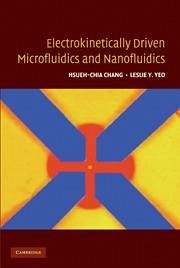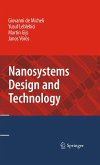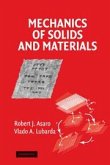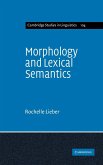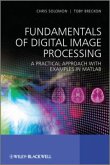- Gebundenes Buch
- Merkliste
- Auf die Merkliste
- Bewerten Bewerten
- Teilen
- Produkt teilen
- Produkterinnerung
- Produkterinnerung
This book provides a fundamental understanding of the mechanisms governing both DC and AC electrokinetic phenomena.
Andere Kunden interessierten sich auch für
![CMOS Biotechnology CMOS Biotechnology]() Donhee Ham / Hakho Lee / Robert M. Westervelt (eds.)CMOS Biotechnology113,99 €
Donhee Ham / Hakho Lee / Robert M. Westervelt (eds.)CMOS Biotechnology113,99 €![CMOS Biotechnology CMOS Biotechnology]() CMOS Biotechnology113,99 €
CMOS Biotechnology113,99 €![Nanosystems Design and Technology Nanosystems Design and Technology]() Giovanni DeMicheliNanosystems Design and Technology103,99 €
Giovanni DeMicheliNanosystems Design and Technology103,99 €![More Than Moore More Than Moore]() Guo Qi Zhang / Alfred van Roosmalen (ed.)More Than Moore113,99 €
Guo Qi Zhang / Alfred van Roosmalen (ed.)More Than Moore113,99 €![Mechanics of Solids and Materials Mechanics of Solids and Materials]() Robert AsaroMechanics of Solids and Materials118,99 €
Robert AsaroMechanics of Solids and Materials118,99 €![Morphology and Lexical Semantics Morphology and Lexical Semantics]() Rochelle LieberMorphology and Lexical Semantics111,99 €
Rochelle LieberMorphology and Lexical Semantics111,99 €![Fundamentals of Digital Image Processing Fundamentals of Digital Image Processing]() Chris SolomonFundamentals of Digital Image Processing98,99 €
Chris SolomonFundamentals of Digital Image Processing98,99 €-
-
-
This book provides a fundamental understanding of the mechanisms governing both DC and AC electrokinetic phenomena.
Produktdetails
- Produktdetails
- Verlag: Cambridge University Press
- Seitenzahl: 526
- Erscheinungstermin: 9. November 2009
- Englisch
- Abmessung: 254mm x 178mm x 30mm
- Gewicht: 1089g
- ISBN-13: 9780521860253
- ISBN-10: 0521860253
- Artikelnr.: 26572621
- Herstellerkennzeichnung
- Libri GmbH
- Europaallee 1
- 36244 Bad Hersfeld
- gpsr@libri.de
- Verlag: Cambridge University Press
- Seitenzahl: 526
- Erscheinungstermin: 9. November 2009
- Englisch
- Abmessung: 254mm x 178mm x 30mm
- Gewicht: 1089g
- ISBN-13: 9780521860253
- ISBN-10: 0521860253
- Artikelnr.: 26572621
- Herstellerkennzeichnung
- Libri GmbH
- Europaallee 1
- 36244 Bad Hersfeld
- gpsr@libri.de
Dr Hsueh-Chia Chang is Bayer Professor in the Department of Chemical and Biomolecular Engineering and Director of the Center for Microfluidics and Medical Diagnostics at the University of Notre Dame. He received his Ph.D. from Princeton University, after which he joined the University of California, Santa Barbara as an Assistant Professor and subsequently the University of Houston as an Associate Professor. Dr Chang has received numerous awards, including the National Science Foundation's Presidential Young Investigator's Award, the Sigma Xi Outstanding Research Award at the University of Notre Dame, and the American Physical Society Division of Fluid Dynamics Francois N. Frenkiel Award. In 1997, he was elected as a Fellow of the American Physical Society. Dr Chang is currently the Editor-in-Chief of the American Institute of Physics journal Biomicrofluidics and an Associate Editor of the SIAM Journal of Applied Mathematics. He has also served on the editorial boards of the International Journal of Bifurcation and Chaos in Applied Sciences and Engineering. Dr Chang's research has culminated in more than 200 journal publications and 12 patents. He is also co-author of Complex Wave Dynamics on Thin Films. Dr Chang has delivered more than 10 keynote lectures and 100 seminars. His former Ph.D. students and postdoctoral researchers currently hold positions at 15 universities worldwide and several major chemical and pharmaceutical research facilities.
1. Introduction and fundamental concepts
2. Classical equilibrium theory due to surface changes
3. Electroosmotic transport
4. Electrophoretic transport and separation
5. Field-induced dielectric polarization
6. DC nonlinear electrokinetics due to field-induced double layer polarization
8. Dielectrophoresis and electrorotation - double layer effects
9. Electrohydrodynamic atomization, electrospinning and discharge driven vortices.
2. Classical equilibrium theory due to surface changes
3. Electroosmotic transport
4. Electrophoretic transport and separation
5. Field-induced dielectric polarization
6. DC nonlinear electrokinetics due to field-induced double layer polarization
8. Dielectrophoresis and electrorotation - double layer effects
9. Electrohydrodynamic atomization, electrospinning and discharge driven vortices.
1. Introduction and fundamental concepts
2. Classical equilibrium theory due to surface changes
3. Electroosmotic transport
4. Electrophoretic transport and separation
5. Field-induced dielectric polarization
6. DC nonlinear electrokinetics due to field-induced double layer polarization
8. Dielectrophoresis and electrorotation - double layer effects
9. Electrohydrodynamic atomization, electrospinning and discharge driven vortices.
2. Classical equilibrium theory due to surface changes
3. Electroosmotic transport
4. Electrophoretic transport and separation
5. Field-induced dielectric polarization
6. DC nonlinear electrokinetics due to field-induced double layer polarization
8. Dielectrophoresis and electrorotation - double layer effects
9. Electrohydrodynamic atomization, electrospinning and discharge driven vortices.

